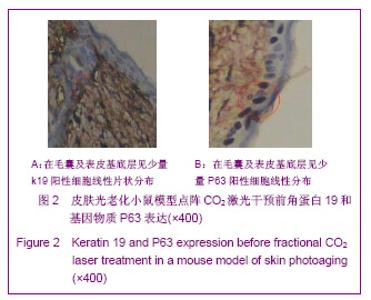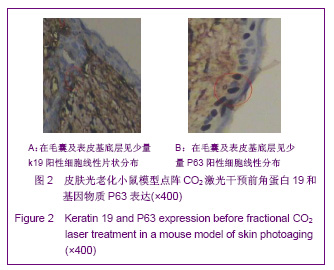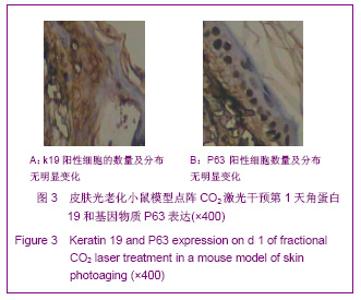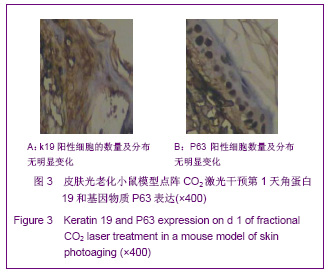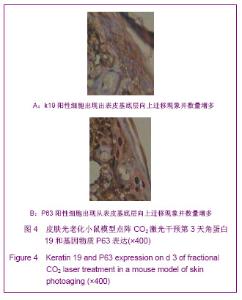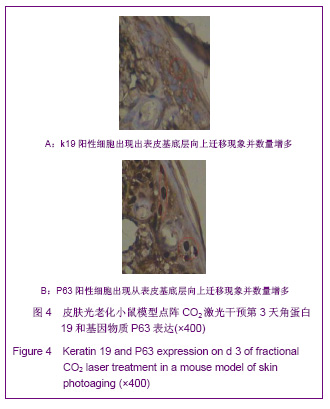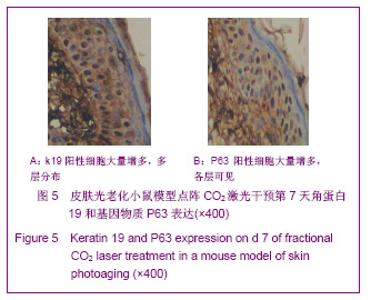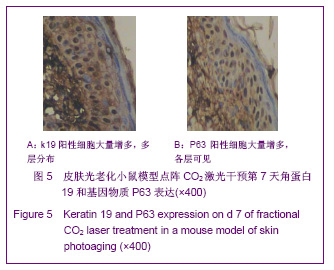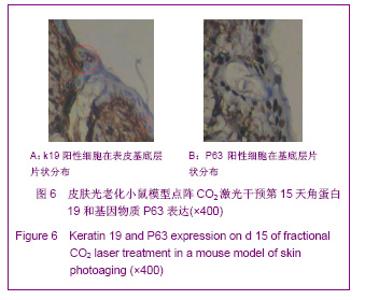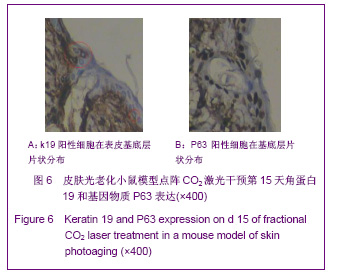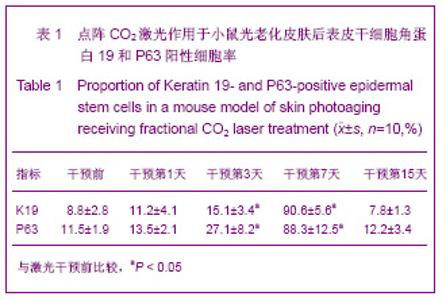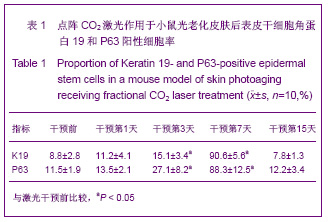Chinese Journal of Tissue Engineering Research ›› 2013, Vol. 17 ›› Issue (6): 1075-1080.doi: 10.3969/j.issn.2095-4344.2013.06.021
Previous Articles Next Articles
Distribution characteristics of epidermal stem cells after treatment with fractional CO2 laser in a model of skin photoaging
Tan Jun, Ding Wei, Li Gao-feng, Li Bo, Qin Xiao-dong
- Department of Laser Cosmetology, People’s Hospital of Hunan Province, Changsha 410005, Hunan Province, China
-
Received:2012-05-17Revised:2012-06-06Online:2013-02-05Published:2013-02-05 -
About author:Tan Jun, Chief physician, Department of Plastic Laser Cosmetology, People’s Hospital of Hunan Province, Changsha 410005, Hunan Province, China doctortanjun@163.com
CLC Number:
Cite this article
Tan Jun, Ding Wei, Li Gao-feng, Li Bo, Qin Xiao-dong. Distribution characteristics of epidermal stem cells after treatment with fractional CO2 laser in a model of skin photoaging[J]. Chinese Journal of Tissue Engineering Research, 2013, 17(6): 1075-1080.
share this article
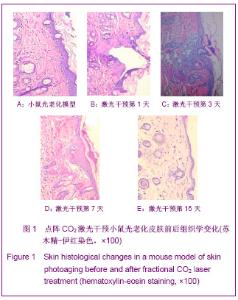
2.1 实验动物数量分析 10只昆明种小白鼠均进入结果分析。 2.2 大体观察皮肤创面愈合情况 治疗过程中可见明显的皮肤收缩,治疗后以四环素眼膏外涂,3次/d。激光干预第1天,小鼠背部创面稍有红肿,无明显渗出。干预第2天,可见部分创面结痂。干预第3天,创面结痂,红肿基本消退,无渗出。干预第4天,创面痂皮出现脱落。干预第7天,创面痂皮基本脱落,创面基本愈合,可见少量毛发生长。干预第15天,创面完全愈合,毛发生长较快,皮肤色素及纹理较前减轻。 2.3 苏木精-伊红染色观察结果 造模后苏木精-伊红染色可见表皮厚度不均,角质层增厚,表皮真皮连接界线清楚,胶原纤维排列紊乱,见图1A。激光干预第1天,可见激光损伤灶周围变性组织及周围细胞水肿,真皮胶原纤维水肿,见图1B。干预第3天,可见炎性细胞浸润,真皮胶原纤维水肿表皮细胞向创底迁移,见图1C。干预第7天,激光损伤灶位置真皮层大量的炎性细胞浸润,变性胶原纤维处可见增生胶原纤维,损伤灶基底见表皮细胞增殖,损伤灶处表皮细胞层次恢复,可见基底层、颗粒层等多层细胞,见图1D。干预第15天,真皮胶原纤维排列有序,紧密,表皮连续性恢复。毛囊有增生,见图1E。"
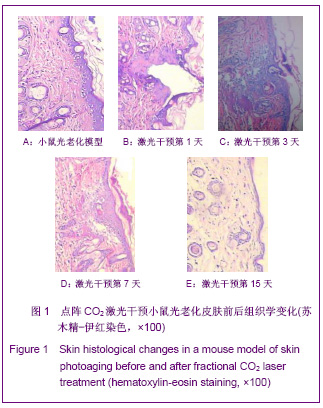
| [1] Slack JM. Stem cells in epithelial tissues. Science. 2000; 287 (5457):1431-1433.[2] Janes SM, Lowell S, Hutter C. Epidermal stem cells. J Pathol. 2002;197(4):479-491.[3] Zhao ZL,Fu XB,Sun TZ,et al.Jiefangjun Yixue Zazhi. 2002; 27(5): 388-389. 赵志力,付小兵,孙同柱,等. 不同发育阶段人皮肤表皮干细胞增殖分化特征及其与创面修复结局关系的研究[J].解放军医学杂志,2002, 27(5):388-389.[4] Liao LX,Chen GQ. Zhongguo Zuzhi Gongcheng Yanjiu yu Linchuang Kangfu. 2007; 14(11): 2661-2664. 廖立新,陈刚泉.应用表皮干细胞构建组织工程皮肤及移植实验[J].中国组织工程研究与临床康复,2007,14(11):2661-2664.[5] Michel M, Török N, Godbout MJ, et al. Keratin 19 as a biochemical marker of skin stem cells in vivo and in vitro: keratin 19 expressing cells are differentially localized in function of anatomic sites, and their number varies with donor age and culture stage. J Cell Sci. 1996;109(Pt 5):1017-1028.[6] Fradette J, Germain L, Seshaiah P,et al. The type I keratin 19 possesses distinct and context-dependent assembly properties. J Biol Chem. 1998;273(52):35176-35184.[7] Pellegrini G, Dellambra E, Golisano O, et al. p63 identifies keratinocyte stem cells. Proc Natl Acad Sci U S A. 2001;98(6): 3156-3161.[8] Reis-Filho JS, Torio B, Albergaria A,et al. p63 expression in normal skin and usual cutaneous carcinomas. J Cutan Pathol. 2002;29(9):517-523.[9] Fu XB,Li JF,Sheng ZY. Zhonghua Shaoshang Zazhi. 2003;19 (1): 5-6. 付小兵,李建福,盛志勇.表皮干细胞:实现创面由解剖修复到功能修复飞跃的新策略[J].中华烧伤杂志,2003,19(1):5-6.[10] Mao QL,Liang ZQ. Zhongguo Zuzhi Gongcheng Yanjiu yu Linchuang Kangfu. 2009;13(27):5301-5304. 毛庆龙,梁自乾.深Ⅱ度烧伤创面磨痂治疗后残留皮肤组织中表皮干细胞标记物角化蛋白19的表达[J].中国组织工程研究与临床康复,2009,13(27):5301-5304.[11] Tao KQ,Li LP. Zhongguo Zuzhi Gongcheng Yanjiu yu Linchuang Kangfu. 2007;11(24):1376-1379. 陶克奇,李利平.自体全层皮肤移植成活过程中表皮干细胞变化规律的实验研究[J].中国组织工程研究与临床康复,2007, 11(24): 1376-1379.[12] Liu ZR,Zhang GW. Guowai Yixue:Pifu Xingbingxue Fence. 2002;26(3):138. 刘仲荣,张国威.皮肤光老化的诊断[J].国外医学:皮肤性病学分册, 2002,26(3):138.[13] Zhang L,Liang H. Guangdong Yixue. 2005;26(12):1642-1643. 张璃,梁红. 小白鼠皮肤光老化模型的建立[J].广东医学,2005, 26(12):1642-1643.[14] Wang Y,Wang JF,Gao S. Zhongguo Yike Daxue Xuebao. 2007; 39(1):64-67. 王奕,王静凤,高森.日本刺参胶原蛋白多肽对紫外线诱导的光老化模型小鼠皮肤的保护作用[J].中国医科大学学报,2007, 39(1):64-67.[15] Fitzpatrick RE, Goldman MP, Satur NM, et al. Pulsed carbon dioxide laser resurfacing of photo-aged facial skin.Arch Dermatol. 1996;132(4):395-402.[16] Roy D. Ablative facial resurfacing. Dermatol Clin. 2005;23(3): 549-559,viii.[17] Manstein D, Herron GS, Sink RK,et al. Fractional photothermolysis: a new concept for cutaneous remodeling using microscopic patterns of thermal injury. Lasers Surg Med. 2004;34(5):426-438.[18] Li HY,Zhang L,Xu HH. Zhonghua Pifuke Zazhi. 2009; 42(7): 500-501. 李远宏,张丽,徐宏慧.超脉冲CO2点阵激光治疗皮肤光老化的临床观察[J].中华皮肤科杂志,2009, 42(7):500-501.[19] Manstein D, Herron GS, Sink RK,et al. Fractional photothermolysis: a new concept for cutaneous remodeling using microscopic patterns of thermal injury. Lasers Surg Med. 2004;34(5):426-438.[20] Fu XB,Cheng T,Sheng ZY. Zhongguo Weizhongbing Jijiu Yixue. 2002;14(1):67-68. 付小兵,程腾,盛志勇. 有关创伤修复与组织再生的现代认识[J].中国危重病急救医学,2002,14(1):67-68.[21] Fu XB,Wang ZG. Beijing:People’s Military Medical Press. 2002: 97-101. 付小兵,王正国.现代高新技术与创伤修复[M].北京:人民军医出版社,2002:97-101.[22] Lan W,Liu DW,Mao YG. Zhongguo Zuzhi Gongcheng Yanjiu yu Linchuang Kangfu. 2008;12(25):4936-4940. 蓝蔚,刘德伍,毛远桂.表皮干细胞生物学特性研究现状[J].中国组织工程研究与临床康复,2008,12(25):4936-4940.[23] Lyle S, Christofidou-Solomidou M, Liu Y,et al. The C8/144B monoclonal antibody recognizes cytokeratin 15 and defines the location of human hair follicle stem cells. J Cell Sci. 1998; 111( Pt 21):3179-3188.[24] Cotsarelis G. Epithelial stem cells: a folliculocentric view. J Invest Dermatol. 2006;126(7):1459-1468.[25] Xie JL,Li TZ,Qi SH,et al.Zhonghua Shaoshang Zazhi. 2003; 19(6): 344-346. 谢举临,利天增,祁少海,等.烫伤大鼠不同深度创面组织中表皮干细胞分布的初步研究[J].中华烧伤杂志,2003 ,19(6): 344-346.[26] Li JF,Fu XB,Sheng ZY. Jiefangjun Yixue Zazhi. 2003;28(7): 588-593. 李建福,付小兵,盛志勇.创面愈合过程中表皮干细胞的分布特征及意义[J] .解放军医学杂志,2003,28(7):588-593.[27] Li JF,Fu XB,Sheng ZY,et al. Zhonghua Yixue Zazhi. 2003; 83(3): 228-231. 李建福,付小兵,盛志勇,等.创面愈合过程中创缘表皮干细胞的再分布[J].中华医学杂志,2003,83(3):228-231.[28] Carter EL, O'Herrin S, Woolery C,et al. Epidermal stem cell factor augments the inflammatory response in irritant and allergic contact dermatitis. J Invest Dermatol. 2008;128(7): 1861-1863.[29] Yao M,Xu WS,Shi JX,et al. Zhonghua Zhengxing Shaoshang Waike Zazhi.1999;15(2):85-90. 姚敏,许伟石,史济湘,等.大鼠浅度烫伤创面愈合与相关生长因子及受体的基因表达[J].中华整形烧伤外科杂志,1999,15(2): 85-90.[30] Li D. Chongqing:Disan Junyi Daxue.2007. 李丹.创面愈合中SDF-1的表达对表皮干细胞迁移作用的机制研究[D].重庆:第三军医大学,2007. |
| [1] | Pu Rui, Chen Ziyang, Yuan Lingyan. Characteristics and effects of exosomes from different cell sources in cardioprotection [J]. Chinese Journal of Tissue Engineering Research, 2021, 25(在线): 1-. |
| [2] | Zhang Xiumei, Zhai Yunkai, Zhao Jie, Zhao Meng. Research hotspots of organoid models in recent 10 years: a search in domestic and foreign databases [J]. Chinese Journal of Tissue Engineering Research, 2021, 25(8): 1249-1255. |
| [3] | Hou Jingying, Yu Menglei, Guo Tianzhu, Long Huibao, Wu Hao. Hypoxia preconditioning promotes bone marrow mesenchymal stem cells survival and vascularization through the activation of HIF-1α/MALAT1/VEGFA pathway [J]. Chinese Journal of Tissue Engineering Research, 2021, 25(7): 985-990. |
| [4] | Shi Yangyang, Qin Yingfei, Wu Fuling, He Xiao, Zhang Xuejing. Pretreatment of placental mesenchymal stem cells to prevent bronchiolitis in mice [J]. Chinese Journal of Tissue Engineering Research, 2021, 25(7): 991-995. |
| [5] | Liang Xueqi, Guo Lijiao, Chen Hejie, Wu Jie, Sun Yaqi, Xing Zhikun, Zou Hailiang, Chen Xueling, Wu Xiangwei. Alveolar echinococcosis protoscolices inhibits the differentiation of bone marrow mesenchymal stem cells into fibroblasts [J]. Chinese Journal of Tissue Engineering Research, 2021, 25(7): 996-1001. |
| [6] | Fan Quanbao, Luo Huina, Wang Bingyun, Chen Shengfeng, Cui Lianxu, Jiang Wenkang, Zhao Mingming, Wang Jingjing, Luo Dongzhang, Chen Zhisheng, Bai Yinshan, Liu Canying, Zhang Hui. Biological characteristics of canine adipose-derived mesenchymal stem cells cultured in hypoxia [J]. Chinese Journal of Tissue Engineering Research, 2021, 25(7): 1002-1007. |
| [7] | Geng Yao, Yin Zhiliang, Li Xingping, Xiao Dongqin, Hou Weiguang. Role of hsa-miRNA-223-3p in regulating osteogenic differentiation of human bone marrow mesenchymal stem cells [J]. Chinese Journal of Tissue Engineering Research, 2021, 25(7): 1008-1013. |
| [8] | Lun Zhigang, Jin Jing, Wang Tianyan, Li Aimin. Effect of peroxiredoxin 6 on proliferation and differentiation of bone marrow mesenchymal stem cells into neural lineage in vitro [J]. Chinese Journal of Tissue Engineering Research, 2021, 25(7): 1014-1018. |
| [9] | Zhu Xuefen, Huang Cheng, Ding Jian, Dai Yongping, Liu Yuanbing, Le Lixiang, Wang Liangliang, Yang Jiandong. Mechanism of bone marrow mesenchymal stem cells differentiation into functional neurons induced by glial cell line derived neurotrophic factor [J]. Chinese Journal of Tissue Engineering Research, 2021, 25(7): 1019-1025. |
| [10] | Duan Liyun, Cao Xiaocang. Human placenta mesenchymal stem cells-derived extracellular vesicles regulate collagen deposition in intestinal mucosa of mice with colitis [J]. Chinese Journal of Tissue Engineering Research, 2021, 25(7): 1026-1031. |
| [11] | Pei Lili, Sun Guicai, Wang Di. Salvianolic acid B inhibits oxidative damage of bone marrow mesenchymal stem cells and promotes differentiation into cardiomyocytes [J]. Chinese Journal of Tissue Engineering Research, 2021, 25(7): 1032-1036. |
| [12] | Guan Qian, Luan Zuo, Ye Dou, Yang Yinxiang, Wang Zhaoyan, Wang Qian, Yao Ruiqin. Morphological changes in human oligodendrocyte progenitor cells during passage [J]. Chinese Journal of Tissue Engineering Research, 2021, 25(7): 1045-1049. |
| [13] | Wang Zhengdong, Huang Na, Chen Jingxian, Zheng Zuobing, Hu Xinyu, Li Mei, Su Xiao, Su Xuesen, Yan Nan. Inhibitory effects of sodium butyrate on microglial activation and expression of inflammatory factors induced by fluorosis [J]. Chinese Journal of Tissue Engineering Research, 2021, 25(7): 1075-1080. |
| [14] | Wang Xianyao, Guan Yalin, Liu Zhongshan. Strategies for improving the therapeutic efficacy of mesenchymal stem cells in the treatment of nonhealing wounds [J]. Chinese Journal of Tissue Engineering Research, 2021, 25(7): 1081-1087. |
| [15] | Liao Chengcheng, An Jiaxing, Tan Zhangxue, Wang Qian, Liu Jianguo. Therapeutic target and application prospects of oral squamous cell carcinoma stem cells [J]. Chinese Journal of Tissue Engineering Research, 2021, 25(7): 1096-1103. |
| Viewed | ||||||
|
Full text |
|
|||||
|
Abstract |
|
|||||
